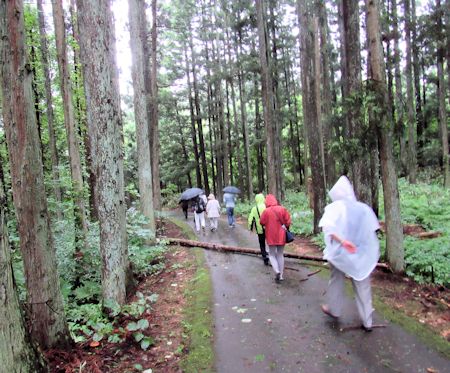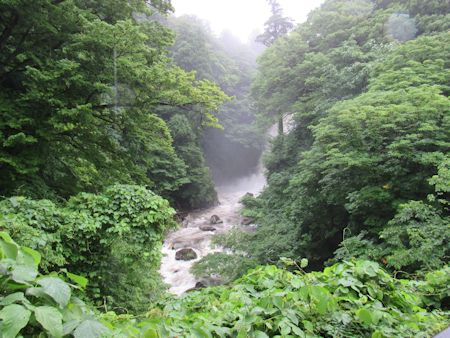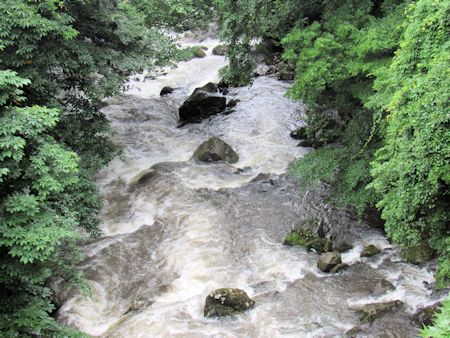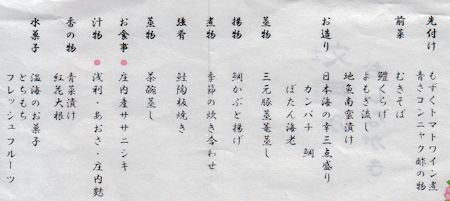|
| Part 2 |
|
| Thursday, July 5, 2018 |
|
We are staying at "Takamiya-villa Kuon" of Atsumi Onsen in Tsuruoka City, Yamagata Prefecture.
Breakfast starts at 7 a.m. I didn't have much appetite and kept the same
amount as usual at home. My wife Emiko is more energetic and has a stronger
appetite than me. |
|
|
|
|
|
We left the hotel at 8:00 a.m. and headed to Shirataki White Falls. Emiko
doesn't forget to take carsick medicine.
Rain as predicted. However, we are in the normal rainy season here. According
to TV this morning, heavy rain is still raging in the west Japan.
After an hour of heading north along the coast of the Japan Sea, we got
to the waterfall, located a little inland.
|
|
|
|
|
| 1.Naso White Falls |
|
| Did we walk for about 20 minutes through the grove and along the river
path? Naso White Falls is falling with a considerable volume and splash
due to the heavy rain. |
|
 |
 |
 |
 |
|
"It is located in the middle of Chokai Blue Line, the road to Mount
Chokai. The waterfall is 11 meters wide and 26 meters high.
The water flowing into Naso River is the snowmelt of Mount Chokai. The
area around the waterfall, where the water flows down with gusto, is full
of negative ions and in cool air." (Nikaho City Tourism Association)
It is insensitive to compare it with Nachi Waterfall of my hometown, but
it has a wild taste, and it is said to be one of the 100 best new Japan
sightseeing spots. |
|
|
|
Naso White Falls, other photos
|
|
| 2.Kisakata |
|
I noticed that Kisakata lagoon facing the Japan Sea at the southern end
of Akita Prefecture is now a land. But what kind of terrain has changed
and how? At the time of the Edo-Genroku period, when Matsuo Basho (1644-89)
was alive, it must have been a lagoon with dozens of small islands floating
in the inner bay, as shown in his travelogue "Oku no Hosomichi"
(The Narrow Road to Oku). What's going on now?
"The seabed was uplifted by the Kisakata Lagoon Earthquake of the
First Year of Bunka (1804) and turned into the land. Later, it was swallowed
up by the development of rice paddies by the reclamation project of the
Honjo Domain, and the historical scenic spot was about to be erased, but
due to the tact and call for life of the resident of Xiaomanji Temple at
that time, the preservation movement increased later, and it became the
appearance of the scenic spot that can be seen today." (Wikipedia)
Inwardly, I was curious and expected to see Kisakata lagoon.
This time, it was only to look it down from the observation floor (6th?) of the Tourism Center. Even in the rain with some unwillingness on foot, it is a pity to me.
There was one islet on the left side of the expansive sea. On the right
side view, waves were crashing on the shore. A statue of Beauty Seishi
on the coastal lawn directly below. That was it.
In any case, Kisakata lagoon in "The Narrow Road to Oku" written
by Basho is as follows. According to the current calendar, it was around
the end of July.
|
|
|
|
|
|
After having seen so many splendid views of both land and sea, I could
think of nothing now but Kisakata.
..... (omission)
The next morning the weather cleared beautifully. When the morning sun rose in all its splendor, we took a boat out on the lagoon of Kisakata. We put in first at Noin Island, where we visited the remains of the hut in which Noin lived in seclusion for three years. On the opposite shore, when we landed from our boat, we saw the old cherry tree that stands as a memento of Saigyo, who wrote of it: "Fishermen must row their boats above the cherry blossoms.
Near the water is a tomb they say is the Empress Jingu's, and the temple
standing nearby is called the Ebb-and-Flow-Pearls Temple. I had never before
heard that the Empress had come this way. I wonder if it is true.
Seated within the priests' quarters of the temple, I rolled up the bamboo
blinds and took in all at once the whole spectacle of Kisakata. To the
south loomed Mount Chokai, supporting the heavens; its image was reflected
in the water. To the west, one can see as far as Muyamuya Barrier; to the
east, the road over the embankment leads to Akita in the distance. The
sea is to the north. The place where the waves of the sea break into the
lagoon is called Tide-Crossing. Kisakata is about two miles in either direction.
Kisakata resembles Matsushima, but there is difference. Matsushima seems
to be smiling, but Kisakata wears a look of grief. There is a sadness mingled
with the silent calm, a configuration to trouble the soul.
象潟や雨に西施がねぶの花
Kisakata--
Seishi sleeping in the rain,
Wet mimosa blossams.
汐越や鶴はぎぬれて海涼し
Tide-Crossing--
The crane's long legs are wetted
How cool the sea is!
English translation: Donald Keene, 2007
|
On the bus from Kisakata to the next famous spot, inspired by Basho's haiku
poem, I enjoyed this kind of trivial haiku. (No English translation. Sorry.)
三輪が崎時化に鯨が熊野灘
孔島沖鯨潮吹く浜に海女
潮を吹く鯨沖合い海女焚き火
|
|
| Kisakata, other photos |
|
| 3.Dakigaeri Gorge |
|
It is located in Semboku City, Akita Prefecture.
Our couple went to the hot spring resorts around Lake Tazawa and also visited
Kakunodate, but it is a scenic spot that I never imagined at the time.
According to Wikipedia:
Located in the middle of Tamagawa River, a tributary of Omono River, it
is about 10 km long and has been designated as "the Prefectural Natural
Park of Dakigaeri with Lake Tazawa.
It is a scenic spot nicknamed Yabakei in the Northeast, and it is said
to be embraced by one hot spring, six falls and three strangely shaped
rocks. Highlights include various strangely shaped rocks and beautiful
falls.
It is located to the south of Lake Tazawa, and downstream is Kakunodate
known for Small Kyoto in Michinoku. That's why many tourists, especially
during the autumn foliage season, a great many tourists come here for a
walk.
|
|
|
|
|
| Dakikaeri Gorge, other photos |
|
Before 5 o'clock in the evening, we arrived at Aomori Winery Hotel of Ohwani
Onsen.
Our couple decided to have dinner at 7 o'clock, because the Tsugaru shamisen
concert at the dining hall is planned from 7:30.
Eat "Oshinagaki" dishes with wine and beer.

The Tsugaru shamisen of the two men was inspiring and moving. I was intoxicated
with the concert for about 30 minutes.
|
|
|
Tsugaru-shamisen Concert, other photos
Today's bus mileage: 360 km.
|
|
| Part 2 Reading: 12' 58" |
|
|
|
|
|
|
|
|

